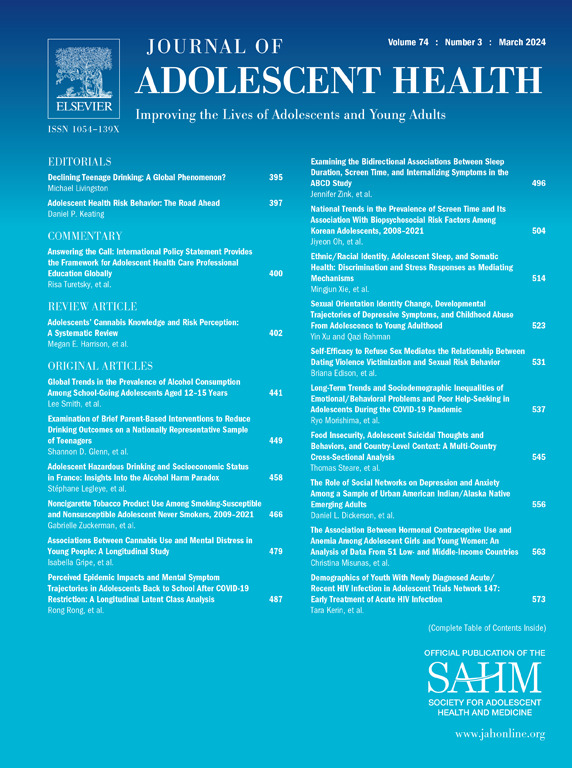Race and Ethnicity Moderates the Relationship Between Family Income Level and Allostatic Load Among Adolescents in the United States
IF 4.5
2区 医学
Q1 PEDIATRICS
引用次数: 0
Abstract
Purpose
People from low-income households are at risk of high allostatic load (AL) in adulthood, which is linked to poor physical and mental health outcomes. It is unclear how early the income–AL link develops and whether this association differs by race and/or ethnicity. We examined associations of family income with high AL among adolescents and whether race and/or ethnicity modified associations.
Methods
Cross-sectional, nationally representative data came from 748 US adolescents (aged 12–17 years) who participated in the prepandemic 2017–March 2020 National Health and Nutrition Examination Survey. Family income was measured using poverty–income ratio (PIR) and categorized as low income (PIR <1.0), middle income (PIR 1.0–4.0), and high income (PIR >4.0). AL was derived from 9 biomarkers. Modified Poisson regression models estimated prevalence ratios (PRs) for associations of family income with high AL overall and stratified by race and/or ethnicity (non-Hispanic White, non-Hispanic Black, and Hispanic).
Results
Nearly 1 in 5 adolescents (19.7%) met the criteria for high AL. Compared to high-income peers, middle-income adolescents had more than twice the prevalence of high AL (PR: 2.16; 95% confidence interval: 1.13–4.13), and low-income adolescents had nearly triple the prevalence of high AL (PR: 2.98; 95% confidence interval: 1.76–5.04). Stratified models observed these associations only for non-Hispanic White adolescents, while for non-Hispanic Black and Hispanic youth, associations were attenuated and nonsignificant.
Discussion
Higher family income was protective against high AL only for non-Hispanic White adolescents. Minority youth may face additional stressors that diminish the protective effects of higher income.
种族和民族调节美国青少年家庭收入水平和适应负荷之间的关系。
目的:低收入家庭的人在成年期面临高适应负荷(AL)的风险,这与身体和心理健康状况不佳有关。目前还不清楚收入与智商之间的联系发展得有多早,以及这种联系是否因种族和/或民族而异。我们研究了家庭收入与青少年高AL的关系,以及种族和/或民族是否改变了这种关系。方法:横断面的、具有全国代表性的数据来自748名美国青少年(12-17岁),他们参加了2017- 2020年3月全国健康和营养检查调查。使用贫困收入比(PIR)衡量家庭收入,并将其归类为低收入(PIR 4.0)。AL来源于9种生物标志物。修正泊松回归模型估计了家庭收入与总体高AL相关的患病率比(pr),并按种族和/或民族(非西班牙裔白人、非西班牙裔黑人和西班牙裔)分层。结果:近1 / 5的青少年(19.7%)符合高AL标准。与高收入同龄人相比,中等收入青少年的高AL患病率是其两倍多(PR: 2.16;95%可信区间:1.13-4.13),低收入青少年的高AL患病率几乎是其三倍(PR: 2.98;95%置信区间:1.76-5.04)。分层模型仅在非西班牙裔白人青少年中观察到这些关联,而在非西班牙裔黑人和西班牙裔青少年中,关联减弱且不显著。讨论:较高的家庭收入仅对非西班牙裔白人青少年的高AL有保护作用。少数族裔青年可能会面临额外的压力,从而削弱高收入的保护作用。
本文章由计算机程序翻译,如有差异,请以英文原文为准。
求助全文
约1分钟内获得全文
求助全文
来源期刊

Journal of Adolescent Health
医学-公共卫生、环境卫生与职业卫生
CiteScore
10.40
自引率
3.90%
发文量
526
审稿时长
46 days
期刊介绍:
The Journal of Adolescent Health is a scientific publication dedicated to enhancing the health and well-being of adolescents and young adults. Our Journal covers a broad range of research topics, spanning from the basic biological and behavioral sciences to public health and policy. We welcome a variety of contributions, including original research papers, concise reports, literature reviews, clinical case reports, opinion pieces, and letters to the editor. We encourage professionals from diverse disciplines such as Anthropology, Education, Ethics, Global Health, Health Services Research, Law, Medicine, Mental and Behavioral Health, Nursing, Nutrition, Psychology, Public Health and Policy, Social Work, Sociology, and Youth Development to share their expertise and contribute to our mission of promoting adolescent health. Moreover, we value the voices of young individuals, family and community members, and healthcare professionals, and encourage them to submit poetry, personal narratives, images, and other creative works that provide unique insights into the experiences of adolescents and young adults. By combining scientific peer-reviewed research with creative expressions, our Journal aims to create a comprehensive understanding of the challenges and opportunities in adolescent and young adult health.
 求助内容:
求助内容: 应助结果提醒方式:
应助结果提醒方式:


